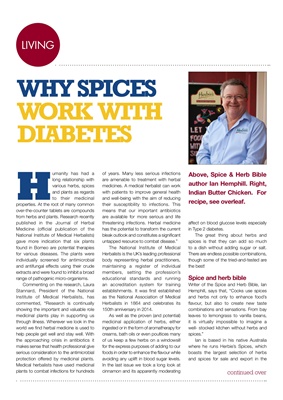
LIVINGLIVING
continued over
H
umanity has had a
long relationship with
various herbs, spices
and plants as regards
to their medicinal
properties. At the root of many common
over-the-counter tablets are compounds
from herbs and plants. Research recently
published in the Journal of Herbal
Medicine (official publication of the
National Institute of Medical Herbalists)
gave more indication that six plants
found in Borneo are potential therapies
for various diseases. The plants were
individually screened for antimicrobial
and antifungal effects using their crude
extracts and were found to inhibit a broad
range of pathogenic micro-organisms.
Commenting on the research, Laura
Stannard, President of the National
Institute of Medical Herbalists*, has
commented, "Research is continually
showing the important and valuable role
medicinal plants play in supporting us
through illness. Wherever we look in the
world we find herbal medicine is used to
help people get well and stay well. With
the approaching crisis in antibiotics it
makes sense that health professional give
serious consideration to the antimicrobial
protection offered by medicinal plants.
Medical herbalists have used medicinal
plants to combat infections for hundreds
WHY SPICES
WORK WITH
DIABETES
of years. Many less serious infections
are amenable to treatment with herbal
medicines. A medical herbalist can work
with patients to improve general health
and well-being with the aim of reducing
their susceptibility to infections. This
means that our important antibiotics
are available for more serious and life
threatening infections. Herbal medicine
has the potential to transform the current
bleak outlook and constitutes a significant
untapped resource to combat disease."
*The National Institute of Medical
Herbalists is the UK's leading professional
body representing herbal practitioners,
maintaining a register of individual
members, setting the profession's
educational standards and running
an accreditation system for training
establishments. It was first established
as the National Association of Medical
Herbalists in 1864 and celebrates its
150th anniversary in 2014.
As well as the proven (and potential)
medicinal application of herbs (either
ingested or in the form of aromatherapy
for creams, bath oils or even poultices
many of us keep a few herbs on a
windowsill for the express purposes of
adding to our foods in order to up the
flavour while avoiding any uplift in blood
sugar levels. In the last issue we took a
long look at cinnamon and its apparently
moderating affect on blood glucose levels
especially in Type 2 diabetes.
The great thing about herbs and
spices is that they can add so much to
a dish without adding sugar or salt, and
there are endless possible combinations,
thought some of the tried-and-tested are
the best!
Spice and herb bible
Writer of the Spice and Herb Bible, Ian
Hemphill, says that "Cooks use spices
and herbs not only to enhance food's
flavour, but also to create new taste
combinations and sensations. From bay
leaves to lemongrass to vanilla beans,
it is virtually impossible to imagine a
well- stocked kitchen without herbs and
spices."
Ian is based in his native Australia
where he runs Herbie's Spices, which
boasts the largest selection of herbs
and spices for sale and export in the
Above, Spice and herb Bible
author Ian Hemphill. Right,
Indian Butter Chicken. For
recipe, see overleaf.